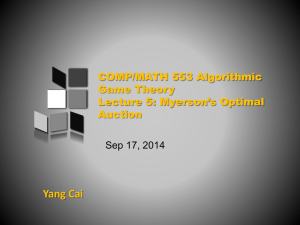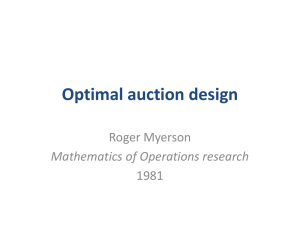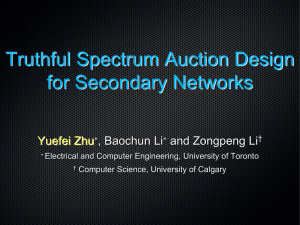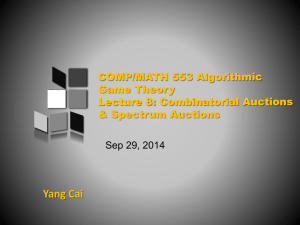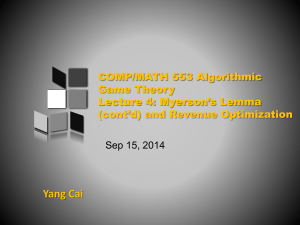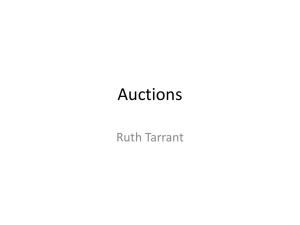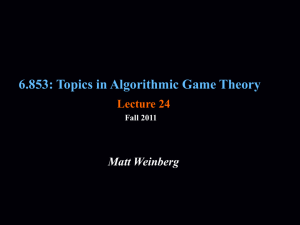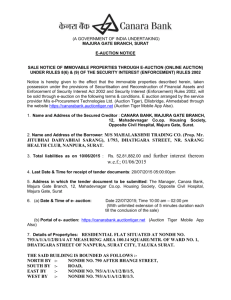Slides
advertisement
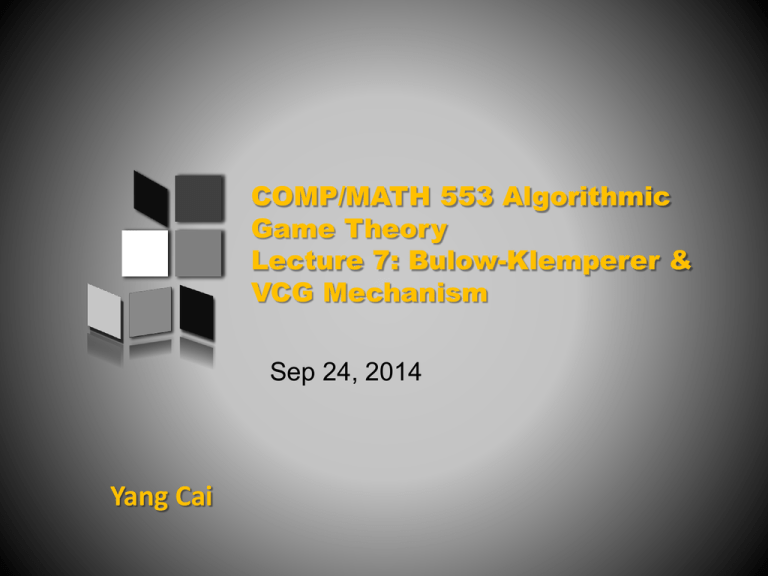
COMP/MATH 553 Algorithmic Game Theory Lecture 7: Bulow-Klemperer & VCG Mechanism Sep 24, 2014 Yang Cai An overview of today’s class Prior-Independent Auctions & Bulow-Klemperer Theorem General Mechanism Design Problems Vickrey-Clarke-Groves Mechanism Prior-Independent Auctions Another Critique to the Optimal Auction What if your distributions are unknown? When there are many bidders and enough past data, it is reasonable to assume you know exactly the value distributions. But if the market is “thin”, you might not be confident or not even know the value distributions. Can you design an auction that does not use any knowledge about the distributions but performs almost as well as if you know everything about the distributions. Active research agenda, called prior-independent auctions. Bulow-Klemperer Theorem [Bulow-Klemperer ’96] For any regular distribution F and integer n. Remark: - Vickrey’s auction is prior-independent! - This means with the same number of bidders, Vickrey Auction achieves at least n-1/n fraction of the optimal revenue. (exercise) - More competition is better than finding the right auction format. Proof of Bulow-Klemperer • Consider another auction M with n+1 bidders: 1. Run Myerson on the first n bidders. 2. If the item is unallocated, give it to the last bidder for free. • This is a DSIC mechanism. It has the same revenue as Myreson’s auction with n bidders. • Notice that it’s allocation rule always gives out the item. • Vickrey Auction also always gives out the item, but always to the bidder who has the highest value (also with the highest virtual value). • Vickrey Auction has the highest virtual welfare among all DSIC mechanisms that always give out the item! ☐ General Mechanism Design Problem (Multi-Dimensional) Multi-Dimensional Environment So far, we have focused on single-dimensional environment. In many scenarios, bidders have different value for different items. - Sotherby’s Auction: Multi-Dimensional Environment - n strategic participants/agents, - a set of possible outcomes Ω. - agent i has a private value vi(ω) for each ω in Ω (abstract and could be large). Examples of Multi-Dimensional Environment Single-item Auction in the single-dimensional setting: - n+1 outcomes in Ω. - Bidder i only has positive value for the outcome in which he wins, and has value 0 for the rest n outcomes Single-item Auction in the multi-dimensional setting: - Imagine you are not selling an item, but auctioning a startup who has a lot of valuable patents. - n companies are competing for it. - Still n+1 outcomes in Ω. - But company i doesn’t win, it might prefer the winner to be someone in a different market other than a direct competitor. - So besides the outcome that i wins, i has different values for the rest n outcomes. How do you optimize Social Welfare (Non-bayesian)? What do I mean by optimize social welfare (algorithmically)? - ω* := argmaxω Σi vi(ω) How do you design a DSIC mechanism that optimizes social welfare. - Take the same two-step approach. - Sealed-bid auction. Bidder i submits bi which is indexed by Ω. - Allocation rule is clear: assume bi’s are the true values and choose the outcome that maximizes social welfare. - In single-dimensional settings, once the allocation rule is decided, Myerson’s lemma tells us the unique payment rule. - In multi-dimensional settings, Myerson’s lemma doesn’t apply ... How can you define monotone allocation rule when bids are multi-dimensional? - Similarly, how can we define the payment rule even if we know the allocation rule. Vickrey-Clarke-Groves (VCG) Mechanism The VCG Mechanism [The Vickrey-Clarke-Groves (VCG) Mechanism] In every general mechanism design environment, there is a DSIC mechanism that maximizes the social welfare. In particular the allocation rule is x(b) = argmaxω Σi bi(ω) (1); and the payment rule is pi(b) = maxω Σj≠i bj(ω) – Σj≠i bj(ω*) (2), where ω* = argmaxω Σi bi(ω) is the outcome chosen in (1). Understand the payment rule What does the payment rule mean? pi(b) = maxω Σj≠i bj(ω) – Σj≠i bj(ω*) maxω Σj≠i bj(ω) is the optimal social welfare when i is not there. ω* is the optimal social welfare outcome, and Σj≠i bj(ω*) is the welfare from all agents except i. So the difference maxω Σj≠i bj(ω) – Σj≠i bj(ω*) can be viewed as “the welfare loss inflicted on the other n−1 agents by i’s presence”. Called “externality” in Economics. Example: single-item auction. - If i is the winner, maxω Σj≠i bj(ω) is the second largest bid. - Σj≠i bj(ω*) = 0. - So exactly second-price. The VCG Mechanism [The Vickrey-Clarke-Groves (VCG) Mechanism] In every general mechanism design environment, there is a DSIC mechanism that maximizes the social welfare. In particular the allocation rule is x(b) = argmaxω Σi bi(ω) (1); and the payment rule is pi(b) = maxω Σj≠i bj(ω) – Σj≠i bj(ω*) (2), where ω* = argmaxω Σi bi(ω) is the outcome chosen in (1). Proof: See the board! Discussion of the VCG mechanism DSIC mechanism that optimizes social welfare for any mechanism design problem ! However, sometimes impractical. How do you find the allocation that maximizes social welfare. If Ω is really large, what do you do? - m items, n bidders, each bidder wants only one item. - m items, n bidders, each bidder is single-minded (only like a particular set of items). - m items, n bidders, each bidder can take any set of items. Computational intractable. If you use approximation alg., the mechanism is no longer DSIC.
